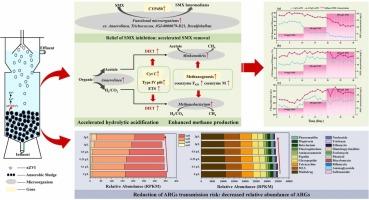纳米级零价铁对废水净化和能源生成的同时效应:磺胺甲噁唑降解和甲烷生成机制
IF 12.2
1区 环境科学与生态学
Q1 ENGINEERING, ENVIRONMENTAL
引用次数: 0
摘要
磺胺甲噁唑(SMX)的存在会对厌氧消化过程产生不利影响,降低废水处理效率和甲烷产量。在这项研究中,外源纳米级零价铁(nZVI)的加入提高了 SMX 的处理效率,并促进了抗生素废水的能量回收。结果表明,在不同的 SMX 进水浓度(50、100 和 200 mg/L)下,与对照反应器相比,添加 0.5 g/L nZVI 的反应器对 SMX 的去除率分别提高了 20%、35% 和 27%,甲烷产量分别提高了 21.6%、40.9% 和 26.6%。微生物群落分布表明,nZVI 通过调节 Anaerolinea 和 Methanothrix 等功能菌的相对丰度,促进了产酸菌和甲烷菌之间的有效合作。同时,nZVI 还能有效促进种间直接电子传递(DIET),并通过充当导电粒子和增加细胞色素 C(Cyt C)及 IV 型纤毛相关基因的丰度来增强电子传递系统(ETS)的活性。此外,nZVI 还能通过降低 ARGs 的相对丰度来降低抗生素耐药基因(ARGs)传播的风险。总之,本研究可为含有 SMX 的抗生素废水的高效厌氧生物修复和能量回收提供新的见解和理论支持。本文章由计算机程序翻译,如有差异,请以英文原文为准。

Simultaneous effects of nanoscale zero-valent iron on wastewater decontamination and energy generation: Mechanisms of sulfamethoxazole degradation and methanogenesis
The presence of sulfamethoxazole (SMX) can adversely affect the anaerobic digestion process, reducing the efficiency of wastewater treatment and methane production. In this study, the addition of exogenous nanoscale zero-valent iron (nZVI) enhanced the efficient treatment of SMX and promoted the energy recovery from antibiotic wastewater. The results showed that the removal of SMX in the reactor pairs with 0.5 g/L nZVI increased by 20 %, 35 %, and 27 %, and the methane production increased by 21.6 %, 40.9 %, and 26.6 %, respectively, compared with the control reactor at different SMX influent concentrations (50, 100, and 200 mg/L). The microbial community distribution indicated that the nZVI facilitated efficient cooperation between acid-producing and methanogens by regulating the relative abundance of functional bacteria, such as Anaerolinea and Methanothrix. Meanwhile, nZVI can effectively facilitate the direct interspecies electron transfer (DIET) and enhance electron transport system (ETS) activity by functioning as a conductive particle and increasing the abundance of genes related to cytochrome C (Cyt C) and type IV pili. In addition, nZVI can reduce the risk of antibiotic resistance genes (ARGs) transmission by decreasing the relative abundance of ARGs. In summary, this study could provide new insights and theoretical support for efficient anaerobic bioremediation and energy recovery of antibiotic wastewater containing SMX.
求助全文
通过发布文献求助,成功后即可免费获取论文全文。
去求助
来源期刊

Journal of Hazardous Materials
工程技术-工程:环境
CiteScore
25.40
自引率
5.90%
发文量
3059
审稿时长
58 days
期刊介绍:
The Journal of Hazardous Materials serves as a global platform for promoting cutting-edge research in the field of Environmental Science and Engineering. Our publication features a wide range of articles, including full-length research papers, review articles, and perspectives, with the aim of enhancing our understanding of the dangers and risks associated with various materials concerning public health and the environment. It is important to note that the term "environmental contaminants" refers specifically to substances that pose hazardous effects through contamination, while excluding those that do not have such impacts on the environment or human health. Moreover, we emphasize the distinction between wastes and hazardous materials in order to provide further clarity on the scope of the journal. We have a keen interest in exploring specific compounds and microbial agents that have adverse effects on the environment.
 求助内容:
求助内容: 应助结果提醒方式:
应助结果提醒方式:


